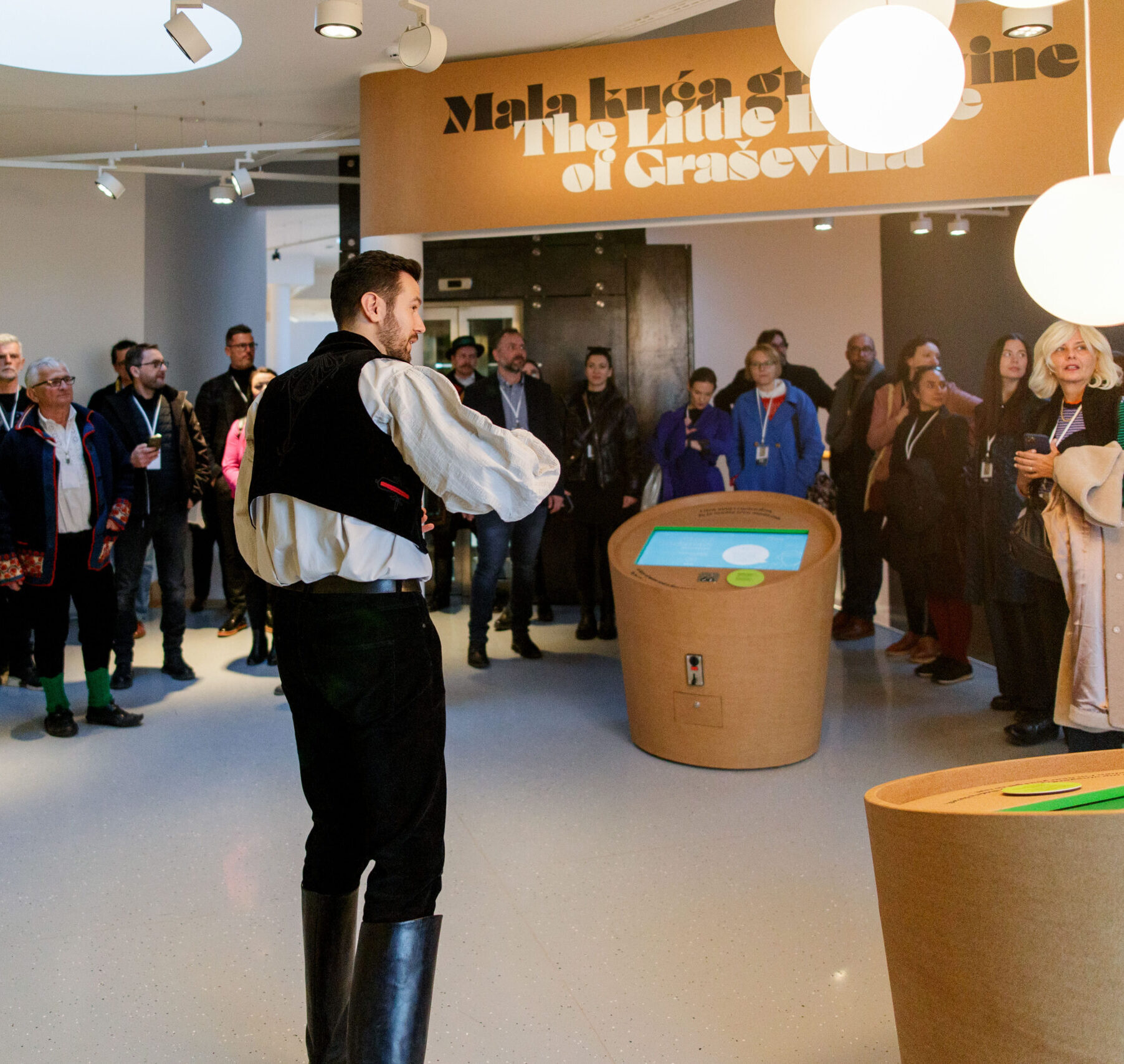The Museum of Bećarac in Croatia opened its doors on 17 February 2023 with the sounds of tamburitza.
This new museum has already welcomed a multitude of people who came to connect to the living heritage of bećarac (becharac) in a new way. Bećarac is a traditional vocal-instrumental song that is considered an intangible cultural heritage of Croatia and is protected by UNESCO. This small but powerful song consists of only two rhyming ten-point verses but sings about nearly all the aspects of one’s life, with an emphasis on love and eroticism.
Bećarac lives through its people
As intangible heritage, bećarac does not exist without the people who live it and protect it. Bećarac, in its humorous and provocative tone, is most often performed as a form of dialogue or vocal duelling. Its vitality lies in its actuality, because despite his centuries-old form (bećarac was first documented in the 18th century) it is still the favourite way of communicating a vast variety of emotions, views and attitudes in Eastern Croatia. People there also like to call it ‘Šokački haiku’ (Shokac haiku).
Presenting the bećarac is therefore unthinkable without connecting visitors to the bećarac heirs themselves. The Museum of Bećarac has become a medium that conveys their voices, while at the same time enabling each visitor to connect to the content in a playful, yet meaningful way.
Intangible heritage through tangible media
The permanent exhibition is organised in five large thematic units covering 426sqm of carefully designed scenography, rich with numerous interactive experiences. The exhibition shows bećarac through the stories of the wine culture of Slavonia, through all phases of human life, through the calendar year and customs, and finally through contemporary and different, sometimes technologically advanced, views.
Each exhibit brings unique experiences that encourage visitors to engage, participate and connect with the exhibition content, but also to connect with each other. The entire exhibition is interwoven with the stories of the native bećari and bećaruše who, through their personal stories in videos, share with visitors their personal connection with this living heritage. Original museum objects form an important part of the display, also carrying their stories woven into them by their owners.
The technology used for exhibits always has a deeper cause, and that is to create a variety of interaction and possibilities for visitor participation. More than 40 multimedia and interactive exhibits depict bećarac through modern and technologically advanced methods, calling every visitor to participate and co-create. You can see and hear intimate stories of individual bećarac heirs through video presentations. Visitors can experience different customs shown in documentaries that have a strong artistic expression. Numerous green screen recordings made for development of some interactive exhibits bring the visitors closer to virtual, but very real, singing contests between the singers of bećarac, or a battle between bećar and a rapper. Visitors can vote for their preferred performance and the votes are added so they can also see who won – bećar or rapper.
Visitors can also leave their mark on this exhibition by assembling the bećarac themselves, dancing with the people of Pleternica wearing the national costume or singing the bećarac with a singing group of bećari and becaruše. One intriguing exhibit allows visitors to meet a robotic bećaruša, who encourages visitors to question the creative power of artificial intelligence.
The long process to develop the exhibition’s rich content
Our interdisciplinary team at Muses Ltd., together with the stakeholders of the Museum of Bećarac, has been present since the very beginning. We have been working on this project for eight years, creating not only important managing documents for the Museum of Bećarac, but also the conceptual and constructional museological documentation. On this final stage, the implementation of the permanent exhibition, we also worked with an immense network of collaborators including co-authors in the areas of graphic and product design, important individuals from the local community and scientific circles, but also a number of great artists and creatives that contributed to the development of the content of this permanent exhibition – production companies, illustrators, photographers, sculptors and animators.
The permanent exhibition includes over 400 bećarac songs, written, translated to English and sung, 50 videos showing the stories of people and displays of various traditional customs, 200 illustrations and photographs, the collection of 200 original museum objects that have been restored and expertly prepared for presentation, all produced in just a few months.
This makes it one of the most comprehensive permanent museum exhibitions in Croatia and a unique home for this intangible heritage that leads every visitor to the heart of Slavonia.
Melita Trbušić has been a member of the team at Muses Ltd since 2019. She dedicates her work in the field of heritage interpretation to the development of different types and forms of visitor experiences and enjoys bringing people closer to their heritage. She can be contacted at: melita.trbusic@muze.hr.
To cite this article: Trbušić, Melita (2023) ‘Bećarac – A small song that tells a big story’ in Interpret Europe Newsletter 1-2023, pg. 17-18.
Available online: https://interpret-europe.net/wp-content/uploads/2023/03/PDF-Newsletter-2023_1-spring.pdf




